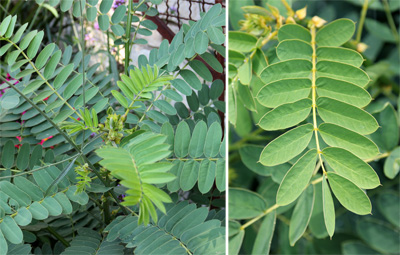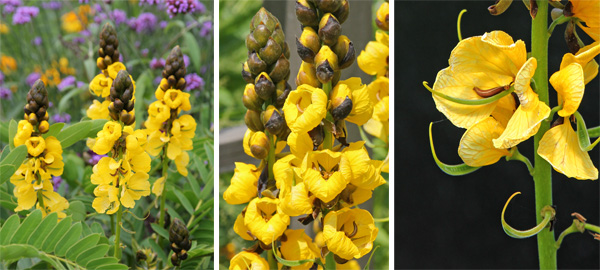
The plant commonly known as popcorn cassia is a legume (family Fabaceae) from tropical central and eastern Africa that is common in disturbed areas, but it is also grown as an ornamental plant world-wide. The species Senna didymobotrya has also been used as a cover crop or green manure crop in some locations. It was previously classified in the genus Cassia, and that has remained as part of its common name. The other part of the common name comes from the scent of the foliage when rubbed – often described as that of buttered popcorn, but other interpretations of the smell include the less appealing “mice” or “wet dog”. Although this tropical plant is only hardy in zones 9-11, because of its rapid growth and habit of flowering when small it is easily used as a seasonal annual in cool climates.
Popcorn cassia is a semi-deciduous, multi-branching shrub or small tree that can grow up to 25 feet tall, but generally remains much shorter (6-10 feet tall). When grown as an annual it may only get a couple of feet tall.

The pinnately compound leaves can grow up to 18” long, although container-grown plants generally have smaller leaves. The 8-18 paired oval leaflets are up to 3 inches long, each with a mucronate apex. The bright green, leathery leaves and rachis are variably pubescent (covered with fine hairs which vary in density and length between individuals).
This plant blooms from spring through fall (but most freely in late summer when temperatures are warm), with dense flower spikes up to one foot tall. The erect axillary racemes have 20-30 rounded flower buds. Each unopened bud is enclosed by a brownish green or black bract that opens to allow the five slightly unequal petals to emerge. These bright, buttery yellow petals are incurved at first, but later become more spreading. The ½ to 2 inch wide flowers have 10 stamens, usually with seven fertile ones with large anthers and three sterile staminodes. The flowers in each inflorescence open at the bottom first and open sequentially up the raceme. Supposedly the flowers smell like peanut butter, although the fragrance is quite subtle.

Flowers are followed by typical legume-type fruits up to 5 inches long. Each flat brown pod contains up to 16 smooth, flattened, bean-like seeds with the pod depressed between the seeds when dry.


In the Midwestern garden, popcorn cassia is used as an unusual accent plant with its bright yellow showy flowers contrasting with its striking black buds, for the tropical effect of its foliage, and for vertical interest with its tall flower spikes. Plant it among other annuals in the border, or as a specimen in a large container. In a mixed container it can function as the “thriller” or tall plant to contrast with other trailing or mid-sized filler plants. The large but feathery foliage contrasts nicely with other tropical with large leaves (such as bananas, elephant ears or castor bean) or anything with dark-colored leaves. Try mixing it with pink cosmos and orange dahlias for a bright burst of color, or use it with yellow dahlias and snapdragons for a sophisticated monochromatic color scheme.

Senna didymobotrya grows best in full sun in rich, moist, well-drained soil. Provide with ample water and fertilize regularly to promote lush growth and flowering. As a tropical plant it will languish in cool weather, but will thrive in the heat and humidity of summer. Prune after flowering to keep more compact, but this will delay repeat blooming. It does not have any significant pests and is not favored by deer.
Although it will tolerate light frost, if you want to try to keep this plant over the winter in a greenhouse or a bright window, try to bring it indoors when nighttime temperatures are in the high 30’s.
Popcorn cassia can be grown from seed, but for use as an annual it is more typically purchased as a rooted cutting. Seed will germinate more readily if soaked in water for 24 hours or scarified mechanically or in boiling water. Sow shallowly in February or March. Wait until all danger of frost has passed before planting outdoors, either in containers or in the ground (at the same time you would put tomatoes outside). Place plants about 2 feet apart.
– Susan Mahr, University of Wisconsin – Madison
Latest from Wisconsin Yard & Garden
Ask Your Gardening Question
If you’re unable to find the information you need, please submit your gardening question here:





 Marigolds
Marigolds Create a Butterfly Garden
Create a Butterfly Garden Plant Flowers to Encourage Beneficial Insects
Plant Flowers to Encourage Beneficial Insects Forcing Bulbs
Forcing Bulbs


